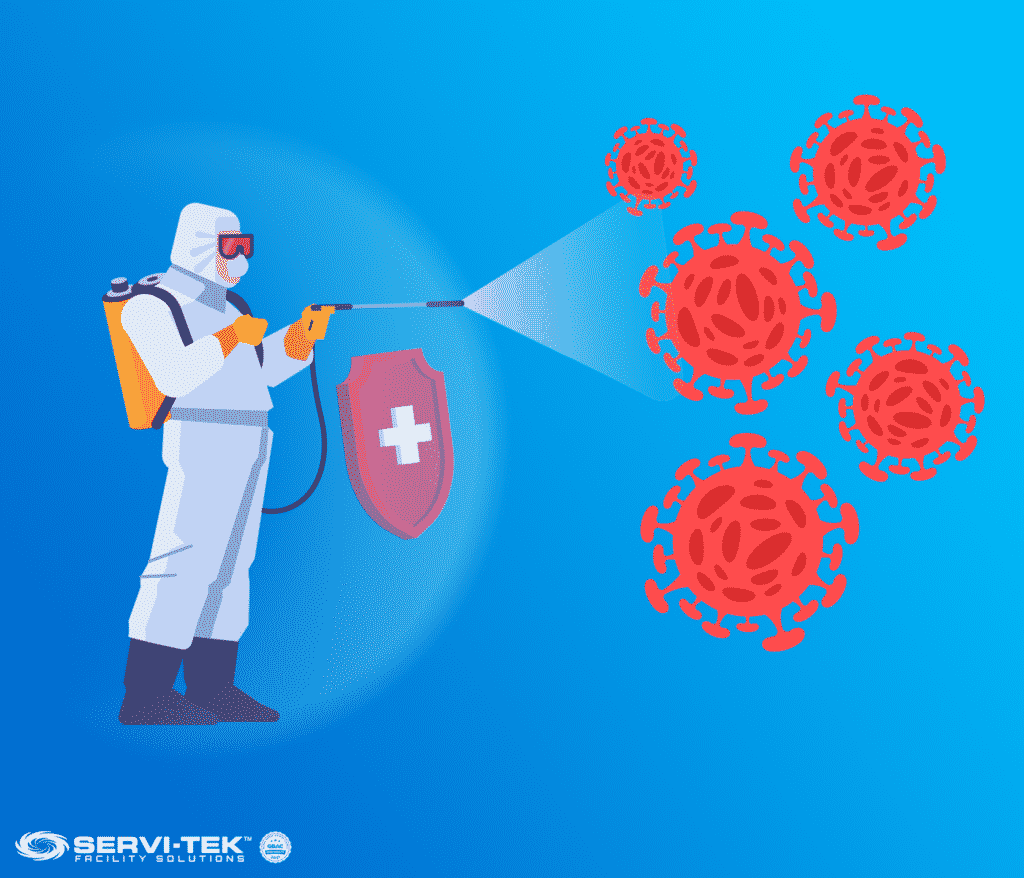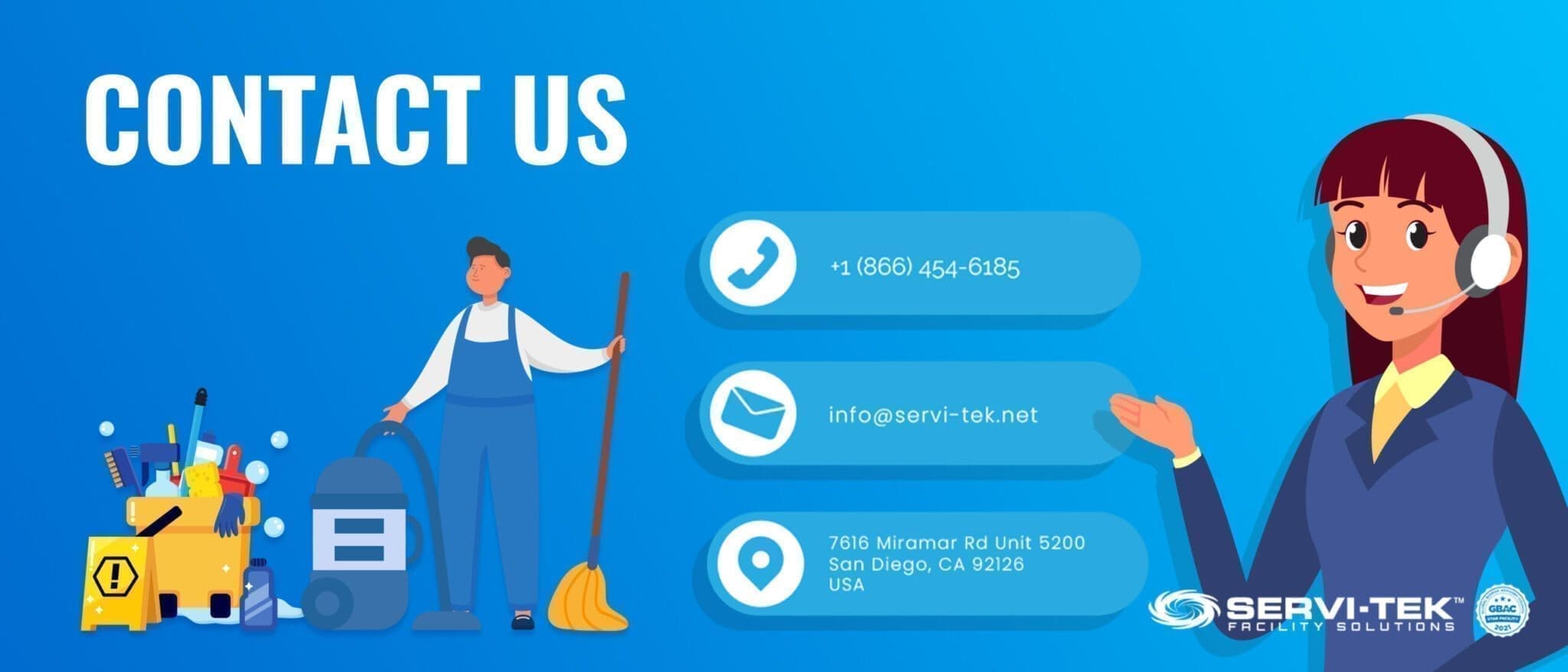
In this pandemic era, most businesses recognize that higher expectations exist regarding cleaning and disinfection practices in occupational environments.
A recent NBC News report suggests that roughly half of adults feel “uneasy” about workplace health and safety. Some employees worry about interactions with unvaccinated individuals at work and the potential for spreading other viral or bacterial illnesses.
In response to these concerns, commercial real estate management professionals in roles such as facilities, operations, and maintenance are challenged to reassess.
Some of these efforts are compliance-related in response to newly implemented local requirements, public health guidelines, or corporate initiatives. Significant concerns for property and facility managers are related to the efficacy of their disinfectants and the required frequency of disinfection.
Some of the key considerations regarding workplace disinfection are as follows:
Cleaning vs. Disinfecting

There is a clear difference between routine cleaning services and disinfecting. Cleaning refers to the process of removing dirt, debris, dust, and germs using either a soap or detergent and water. Cleaning removes germs – comprised of bacteria, viruses, and fungi; however, it does not automatically kill germs.
When a surface is cleaned, the number of germs that remain is limited and making the disinfection process more effective. Conversely, it is also important to recognize that applying disinfectant alone does not automatically also clean the surface.
The best course of action is to clean and then disinfect to realize the greatest results. Disinfecting kills bacteria and viruses on surfaces or objects. Disinfecting works by using chemicals to kill germs on surfaces or objects, which can further lower the risk of spreading infection.
Bacteria and Virus Go Mobile
The following list summarizes four common ways that harmful germs can be transmitted in a commercial real estate facility setting:
- Droplets: Respiratory droplets can travel roughly six feet between people and transmit germs to others who breathe them in or have exposure to their eyes or nose.
- Airborne: Fortunately, many germs are unlikely to spread through airborne transmission. Those that most commonly are spread in this manner include chickenpox, measles, and tuberculosis.
- Direct Contact: Pathogens are commonly transmitted via close contact, particularly those that only survive when exposed to a host.
- Indirect Contact: The most common means of indirect contact transmission occurs when germs exist on surfaces. Some of the typical locations include handrails, doorknobs, light switches, etc.
Reasons to Disinfect

Prevent the Spread of Infection
An infection is defined as a harmful occurrence to the body that results from pathogens such as viruses or bacteria. Since the spread of COVID-19, it has become critical to clean high-touch surfaces and high-traffic areas in commercial real estate settings. The Environmental Protection Agency (EPA) and the Center for Disease Control and Prevention (CDC) have provided guidance and disease control measures.
Efforts to limit the transmission of viruses have involved using personal protective equipment (PPE) including masks and gloves. Many commercial disinfection service providers have begun offering electrostatic spraying that results in complete coverage from floor to ceiling. Electrostatic disinfection is not practical during business hours; therefore, high-touch locations including handrails and elevator buttons will require manual disinfection.
Another disinfection-related challenge exists in multi-shift facilities where the subsequent staff occupies the same workspace. Here, it becomes necessary to ensure that these areas are sufficiently cleaned and disinfected.
The People Factor
The CDC recommends that facilities take a common sense approach to workplace disinfection. For example, ensuring that occupants have easy access to hand sanitizer.
The health and safety of employees, tenants, customers, and visitors operating in a workplace setting are among the top reasons for cleaning and disinfection. Aside from reducing bacteria, viruses and other pathogens, a properly cleaned and disinfected office has proven to boost employee mood and overall morale.
Commercial real estate assets which have customers physically visit their location, including professional practices, service industries, and retailers, must focus on disinfection to avoid the spread of covid-19.
When customers have alternatives or options of who they do business with they tend to prefer properties or facilities that provide peace of mind. Studies suggest that customers will form opinions about the quality of an organization based on the physical condition of the premises.
Key Areas to Disinfect

Common Areas
Key areas of a commercial facility or building that would most benefit from ongoing disinfection are the busy, high-traffic areas and surfaces. Some examples of these areas include lobbies, elevators, staircases, and door handles. The recommended frequency of disinfection may vary based on the volume of foot traffic, the size of the space, and more.
While these areas generally require more frequent disinfection, they also represent challenges in choosing an appropriate disinfectant and application method. For example, in the middle of a workday, you wouldn’t use a very strong bleach-based disinfectant which can result in strong odors and potential adverse reactions.
Employee Break Rooms
The United States Department of Agriculture has guidelines that pertain to properly disinfecting kitchens and other food preparation areas. These areas must be initially cleaned and then sanitized to prevent potentially harmful pathogen contact, exposure, or consumption.
Due to the high-traffic area of shared kitchens and employee break rooms, ongoing disinfection is good, current practice to maximize disease control. Some examples of focus areas include appliance handles, coffee machines, countertops, and tables/chairs.
Restrooms
Much in the same manner as employee break rooms, restrooms withstand heavy usage throughout all periods of the day. Users are forced to touch numerous surfaces, such as partition doors, flush handles, soap dispensers, and faucets.
Nowhere is both cleaning and disinfecting more critical to maintaining the expectations and satisfaction of employees, tenants, and visitors. Cleaning services should utilize industrial or hospital-grade disinfectants to insure bacteria, viruses, and other pathogens are killed.
Office Workspace
Cleaning and disinfecting the office workspace are among the best prevention practices for health and wellness. Some of the items that need attention include phones, keyboards, surfaces, doorknobs, light switches, and others that are commonly touched.
It is also critical to use agents that are appropriate for the type of surface such as laminate, wood, plastic, etc. Surfaces and areas – such as workstations – which are shared amongst staff represent potentially high areas of potential transmission.
Disinfecting Cleaning Products
Disinfection products are intended to kill bacteria, viruses, and fungi. Due to the spread of covid-19, focus on this category of janitorial chemicals has reached an all-time high as commercial real estate assets seek to maximize prevention measures. Disinfection products include the following:
- Alcohol.
- Chlorine and chlorine compounds.
- Formaldehyde.
- Glutaraldehyde.
- Hydrogen peroxide.
- Iodophors.
- Ortho-phthalaldehyde (OPA)
- Peracetic acid.
- Peracetic acid and hydrogen peroxide
- Phenolics
- Quaternary ammonium compounds
Commercial formulations based on these chemicals are unique products and must be registered with EPA or cleared by the Food and Drug Administration (FDA). Always ensure your cleaning services follow the label directions for safe and effective use. Personal protective equipment (PPE), such as gloves, goggles, or eyewear, should be utilized as directed.
Some of the common, well-known household disinfection products are Clorox and Lysol.
Disinfectants which kill the coronavirus SARS-CoV-2 (covid-19) must be on the EPA products List N. Inclusion on the List N does not constitute an endorsement by EPA. Additional disinfectants may meet the criteria for use against SARS-CoV-2 (COVID-19), so the EPA updates the listing, as required.
Many disinfectants include specifications that require that they be left on the surface for a specified amount of time to dry to maximize effectiveness. The period is known as the dwell time or kill time.
Kill Mold Before It Becomes a Problem

The best way to kill mold and mildew is to treat areas with an EPA–registered mold and mildew disinfectant. These specially formulated disinfectants will kill mold spores at their roots, preventing them from reappearing over time.
EPA data suggests that mold is capable of developing on most substances if oxygen and moisture exist. Excessive moisture often will create mold on wood, carpet material, food, drywall, sheetrock, and others when given time to develop. Areas of commercial property or facility where relative humidity exceeds 60% are much more likely to develop mold-related problems.
Certain types of molds can be toxic and cause allergic reactions. Areas of high humidity or those with water damage should be properly ventilated and dehumidified to prevent mold growth.
Electrostatic Disinfection and How it Works
Electrostatic disinfection involves spraying an electronically charged mist of disinfectant chemicals onto surfaces and objects. Electrostatic sprayers propel positively charged disinfecting solutions to electromagnetically stick to the targeted surface, visible area, and touchpoint through an electrode inside the sprayer nozzle.
This disinfection method atomizes cleaning solutions to produce an electrical charge spray able to wrap around surfaces of all types for an even coating.
Benefits of Electrostatic Disinfection
Electrostatic disinfection is an innovative method that saves time, energy, and costs because it presents a more efficient alternative to traditional disinfecting techniques and solution applications. Some benefits of using an electrostatic disinfection process are:
- It reduces the time to cover and disinfect all surfaces and hard-to-reach places by 50% compared to conventional methods.
- It applies chemicals in an efficient, uniform and controlled manner, eliminating the dangers of overuse and reducing the number of chemicals used and waste produced.
- It limits cross-contamination and the movement of bacteria from one surface to another.
- With the proper disinfectant, Improves disease control, infection control, and the spread of viruses, COVID-19.
- Safer and more consistent application with no disruption to existing areas, papers, or surfaces with quick kill time and no residue.
- Spray on keyboards, phones, copiers, and all other electronic high-touch areas without damage or concern.
Contact an Experienced Provider of Commercial Cleaning and Disinfection Services Today
At Servi-Tek Facility Solutions we have years of experience creating full-service customized cleaning and disinfection plans for our commercial clients.
We employ the latest products and equipment innovations available in the industry to deliver truly comprehensive services combined with a client-centric focus.
Our team is prepared to perform specialized offerings including electrostatic disinfection spraying to reduce transmission risks and increase peace of mind.
Please contact our team of professionals today for a consultation.




